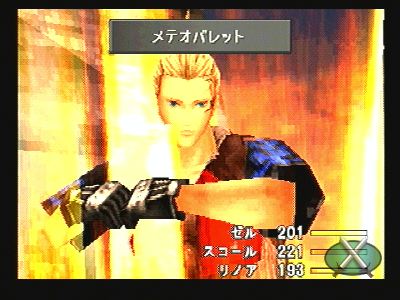 |
Final Fantasy VIII - Review |
 |
Where's the Fantasy?
By: Jake Alley
| Review Breakdown |
| Battle System |
6 |
| Interface |
6 |
| Music/Sound |
8 |
| Originality |
9 |
| Plot |
7 |
| Localization |
7 |
| Replay Value |
5 |
| Visuals |
10 |
| Difficulty |
Medium |
| Time to Complete |
30-60 hours
|
|
| Overall |
 |
| Criteria
|
With each new Final Fantasy, Square creates all new game mechanics, and uses
a slightly more technologically advanced setting. As things progress however, this removes some
of the fantasy from Final Fantasy. The end result of this process of Final Fantasy VIII.
Far from its roots, Final Fantasy VIII features a setting very much like the real
world. Large cities with high populations, cars, and even an advanced space program complete with
TV satellites can all be found. However, this leaves little room for such staples of the series as
Moogles and Chocobos. The story itself however is close to it's roots, saving the world from an evil
witch with her evil empire. The game's producer claims that it has a strong theme of love, but this
isn't very apparent. Most characters in the game receive practically no development, and while those
that are developed do have a budding romance, it isn't nearly as developed as those found in titles
from Game Arts. The plot is however well translated, which is a pleasant surprise in light of the
other titles released by Square in close proximity.

|
| Square's CG artists are the best in the business.
|
|
The true emphasis of Final Fantasy VIII is the Guardian Forces, or summoned monsters
as they are known earlier in the series. While summoning these creatures has long been important
to the series, they is now vital to every aspect of gameplay. When equipped, or "Junctioned" GFs
may be summoned. They also activate commands such as Magic and Item, and allow spells to be junctioned
to stats, increasing them. Without a GF junctioned, characters can do absolutely nothing other
than attacking. Magic also plays a somewhat different role. Rather than the traditional MP, each
spell may only be cast a certain number of times. Spells can be obtained and replenished by drawing,
either from draw points around the world, or monsters, each of which has a specific list of spells
to chose from. While not exactly limiting, this does encourage players to save better spells for
later. However, with no real restriction on summoning GFs, this balancing is rendered somewhat
pointless. Equipment is also somewhat different this time around. Armor and accessories are nowhere
to be found, replaced with junctioning spells to stats. Weapons on the other hand are still purchased,
but first raw materials to create them must be obtained, which can be quite difficult.
Speaking of difficulty, as the levels of your characters increase, monsters become
more powerful to compensate. As the main character must always be in your party, and therefore
constantly gains levels, players are, in a sense punished for changing which characters they use,
as their average level becomes higher than the level of most characters. Changing characters is
also hindered by the rather elaborate degree of customization and micromanagement introduced by
the Junction system.

|
| High detail models |
|
Since GFs are so vital to the game, most players will want to collect them all.
While most GFs can be found easily enough, the best ones all must be obtained by way of difficult
side quests. Going after every GF, and all the best weapons drastically increases the otherwise
standard play time. Even more time-consuming however is what may be the most addictive sub-game
in any RPG, Triple Triad. Triple Triad is a simple trading card game, with cards corresponding to
each character and monster in the game. While doing so has no real effect on the main game, collecting
every possible card is an extremely addictive and time consuming task.
Aside from the intriguing game mechanics, Final Fantasy VIII brings yet another
feature players have come to expect from the series. Mind blowing graphics, particularly FMV. Spanning
four discs, Final Fantasy VIII provides spectacular FMV scenes almost constantly throughout the game.
The in-game graphics are also quite impressive. All characters are realistically proportioned polygonal
models, with lifelike articulation and body language. The only visible flaw is a lack of much needed
anti-aliasing, however this is due to hardware limitations.

|
| Leviathan always looks good. |
|
Sounds match the sights for the most part. While there are a number of filler tracks,
the soundtrack contains enough gems to more than balance them out. From 1980's style techno battle
music, to Latin chanting, to a love song by popular artist Faye Wong, there's something for
everyone.
While any given element of Final Fantasy VIII seems solid enough, the complete
package seems somehow lacking. Perhaps it's the departure from the fantasy setting. Perhaps it's
radical changes to all game mechanics. In any case, Final Fantasy VIII is a very good game which
seems to have a deal of untapped potential. It does however pack in enough challenging side quests to keep
RPGamers busy for quite some time.
|










